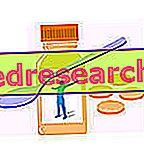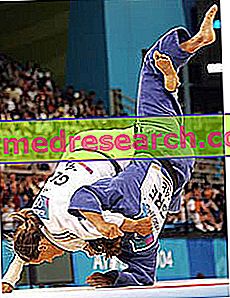Generality
Ophthalmic headache is a particular form of headache accompanied by visual symptoms and / or neurological phenomena. This condition is not considered serious, but the combination of these disorders can temporarily interfere with some daily activities, such as reading or driving.

The visual symptoms of ophthalmic headache are completely reversible and include: photophobia, phosphenes (flashes and flashes of light), scotomas (vision of dark or colored spots) and transient loss of vision. In addition, headaches can be associated with: nausea, dizziness and tingling in the upper limbs.
The causes of ophthalmic headache are still not entirely clear. However, it seems that this form of headache may depend mainly on the vasoconstriction of the blood vessels that supply the eye and its structures, which results in a temporary reduction in local blood flow. Among the factors that can trigger this form of headache are also incorrect sight defects (refractive defects, such as myopia, hypermetropia or astigmatism) and trigeminal nerve neuralgia . Moreover, ophthalmic headache can be favored by asthenopia ( eye fatigue) or by pathologies that make vision difficult (such as cataracts ).
Diagnosis is based on an accurate collection of clinical history and physical examination. In subjects with infrequent ophthalmic headache episodes, treatment is exclusively symptomatic and involves the use of self-medication analgesics and anti-inflammatories, such as ibuprofen and naproxen. In case of recurrent or particularly serious attacks, prophylaxis therapy is indicated.
What is the Ophthalmic Headache
Ophthalmic headache is a form of headache accompanied by visual changes .
Usually, the pain affects only one side of the skull and appears within an hour of the onset of visual symptoms (also with unilateral involvement).
Ophthalmic headache is of a pulsating nature and presents a moderate-severe intensity . This form of headache can be aggravated by movement (for example, walking or climbing steps).
In addition to visual problems, ophthalmic headache can be associated with transient neurological manifestations, such as increased sensitivity to sounds, nausea and vomiting.
Causes
The causes of ophthalmic headache have not been definitively identified. However, it is known that this form of headache depends on the triggering of particular mechanisms, including an alteration of the pain regulation system and an abnormal neurological response to certain stimuli. This altered reactivity is common to almost all people with ophthalmic headache and is favored by various conditions (eg dehydration, visual fatigue, stress, etc.).
Predisposing factors
A combination of genetic and vascular factors appears to be the basis of ophthalmic headache:
- Genetic causes : in some individuals suffering from this form of headache, specific hereditary anomalies have been identified;
- Vascular causes : the disorder can result from a temporary reduction in blood flow (vasoconstriction), caused by the sudden narrowing of the vessels supplying the eyeball and the structures related to it.
Moreover, ophthalmic headache can be associated with specific visual pathologies, such as:
- Incorrect visual defects (myopia, hyperopia or astigmatism);
- Eye strain (asthenopia);
- Ocular diseases that make vision difficult (as in the case of cataracts).
Sometimes, ophthalmic headache can originate from an inflammation of the trigeminal nerve .
Aggravating and / or triggering factors
The factors that can favor or aggravate an episode of ophthalmic headache are numerous and include:
- Dehydration;
- Excessive heat:
- High altitudes;
- Smoke;
- Anxiety and emotional tension;
- Stressful lifestyles;
- Hypertension;
- Hypoglycemia;
- Fluctuation in hormone levels (menstruation, oral contraceptive use and menopause);
- Bad posture;
- drugs;
- Excessive afferent stimuli (eg flashing lights, strong smells and noises);
- Sun exposure;
- Consumption of particular foods, fasting or unbalanced diet (eg excess sodium or abuse of sausages, aged cheeses, nitrites, glutamate, aspartame and chocolate);
- Poor sleep quality or changes in sleep / wake rates.
Ophthalmic headache can also be the consequence of systemic diseases of various kinds, such as atherosclerosis, systemic lupus erythematosus or sickle cell anemia. In other words, headache is a symptom that is induced by a concomitant pathology.
Who is most at risk
The people who tend to develop ophthalmic headache are mainly young women (usually within the age of 40). In addition, the disorder occurs more commonly in individuals who have a personal or family predisposition to exhibit a migraine with aura .
Symptoms and Complications
Ophthalmic headache occurs with repeated attacks of migraine-type headache, associated with visual disturbances . Each episode lasts from a few minutes to several hours.
Ophthalmic headache can temporarily interfere with some activities, such as reading or driving.
Ophthalmic headache: visual disturbances
The visual symptoms that accompany ophthalmic headache attacks are completely reversible . Usually, these events last from 5 to 20 minutes (they never last for more than an hour). The headache persists, however, longer (from 4 hours up to 2-3 days borderline cases).
Visual symptoms associated with ophthalmic headache include:
- Photophobia (increased sensitivity to light);
- Increased tearing;
- Vision of blind spots, dark or colored, fixed or sparkling in the visual field (scotomas);
- Perception of flashes of light or flash in the absence of light (photopsies);
- Partial loss of vision or temporary blindness.
Headache in ophthalmic headache: characteristics
The headache that accompanies ophthalmic headache affects only one side of the skull. The pain appears within an hour of sight problems and is usually pulsating and severe to moderate in intensity.
Ophthalmic headache can be aggravated during daily activities (eg walking or climbing steps) and can be associated with:
- Repulsion for food, nausea and / or vomiting (in particularly strong crises);
- Hypersensitivity or discomfort due to odors (osmophobia) and noise (phonophobia);
- Dizziness;
- Decreased muscle strength;
- Tingling, numbness and reduced sensitivity of a limb or half of the body (typically, paresthesias begin in one hand, spread to the arm and may involve the ipsilateral half-life);
- Loss of sensitivity in the palate;
- Difficulty in expressing words verbally and articulating (aphasic type language disorders);
- Hindrance in the movements of an extremity.
Diagnosis
In the case of ophthalmic headache, it is advisable to have a very thorough eye examination. The diagnosis of this type of headache is often considered "exclusionary"; other conditions can cause, in fact, similar visual problems.
The most important aspect to consider is that, during an episode of ophthalmic headache, the visual symptoms are unilateral, that is, they involve only one eye.
A doctor can diagnose ophthalmic headache by examining personal and family history, collecting information related to the symptoms experienced by the patient.
Differential diagnosis
Before making the diagnosis of ophthalmic headache, it is important to rule out other possible causes of transient monocular blindness (amaurosis fugax), such as:
- Serious eye problems (eg retinal thrombosis);
- Consequences of a stroke or those of a head injury;
- Carotid dissection;
- Optic neuritis.
Therapy
Dealing appropriately with ophthalmic headache, helps reduce the frequency of attacks and limits the associated discomforts.
The first step to be implemented to manage and prevent episodes of ophthalmic headache consists in reducing or, if possible, eliminating the triggers, implementing some lifestyle changes (eg habits related to sleep or diet). If the control of these stimuli is ineffective, it is possible to resort to drug therapy .
In any case, the most appropriate approach to ophthalmic headache must always take into consideration the individual indications established by the doctor, formulated in relation to the extent of the disorder, the symptoms and the personal needs of the patient.
Symptomatic treatment
In subjects who experience few episodes of ophthalmic headache over the course of a year, drug treatment is aimed at relieving pain and rapidly controlling the symptoms associated with a headache attack.
Among the drugs most used in symptomatic therapy are non-steroidal anti-inflammatory drugs ( NSAIDs, such as aspirin or ibuprofen) and triptans (vasoconstrictor active ingredients).
Preventive treatment
In some cases, it is useful to use a prophylactic or preventive drug therapy against ophthalmic headache.
When the disorder often occurs (at least 5 seizures per month) or the symptoms are very serious, a neurologist who specializes in treating headaches can indicate a prophylaxis therapy, aimed at reducing the frequency and severity of attacks. This type of drug treatment involves taking regular medication, often on a daily basis.
The main classes of medicines are:
- Beta blockers and calcium channel blockers : modulate the tone of blood vessels and regulate the mechanisms involved in pain;
- Tricyclic antidepressants : such as amitriptyline or nortriptyline, they act mainly on serotonin receptors;
- Anticonvulsants : like divalproex sodium and topiramate, they act on the pain threshold and on cerebral hyper-excitability.
The doctor will choose whether to prescribe them based on the frequency of ophthalmic headache attacks and the patient's age; following his directions helps to face the problem in the best possible way.
Other useful interventions
A useful strategy to combat ophthalmic headache is the use of glasses to correct any problems or prevent excessive eye fatigue.
Another effective intervention to prevent the disorder consists in acting on all those that may be environmental factors.
In the case of ophthalmic headache caused by stress, for example, it is possible to resort to natural remedies, such as the intake of infusions of valerian, chamomile and lemon balm with a calming action, as well as the practice of yoga.
Some advice
Some dietary-behavioral measures can help to alleviate the symptoms of ophthalmic headache. These include:
- Avoid factors that can promote the onset of headaches, such as cigarette smoke, poorly ventilated areas, alcohol consumption, excessive heat and exposure to intense noise;
- Limit the consumption of foods that may contain monosodium glutamate, nitrites and lactose implicated in the onset of headache attacks: dairy products, aged cheeses, Chinese food, eggs, chocolate, citrus fruits, tomatoes, etc.
- Have periodic checkups with a trusted ophthalmologist to prevent the lack of awareness of a given disorder (eg myopia, astigmatism, hyperopia, etc.) from causing an ophthalmic headache or any other type of problem.



